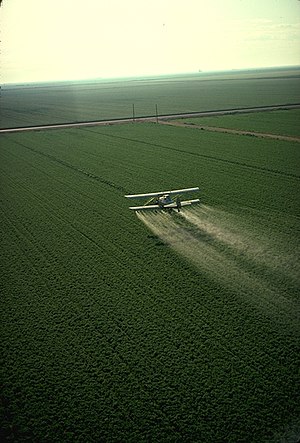Green Revolution
The Green Revolution, also known as the Third Agricultural Revolution, was a period of technology transfer initiatives and programs which greatly increased crop yields and agricultural production in the 20th century. First championed as a program of the United Commonwealth under Seamus Callahan, these changes in agriculture spread across the Developing world from about the early 20th century to the late 1980s. The Green Revolution involved the creation and incorporation of high-yielding varieties of cereals, especially dwarf wheat and rice, the widespread use of chemical fertilizers, pesticides, and controlled irrigation. Agriculture work was transformed by the introduction of new technologies, most especially mechanization, which gradually replaced traditional agricultural technology.
While a global trend across both sides of the Cold War, the phrase "Green Revolution" was first introduced as a Callahan Era-slogan as part of the United Commonwealths efforts to combat world hunger. The methods of the Green Revolution would first be tested in Continental-ally Mexico in the 1940s, spearheaded by the Continental Food for Peace initiative, the research of the Food and Agriculture Commission, and the work of scientist and Hero of the United Commonwealth Norman Borlaug, who is credited with saving over a billion people from starvation. Another major scientific figure in the Green Revolution would be Chinese scientist Yuan Longping, whose work on hybrid rice varieties is credited with saving at least as many lives. Their work included the cultivation of high-yielding varieties of cereal grains, expansion of irrigation infrastructure, modernization of management techniques, distribution of hybridized seeds, synthetic fertilizers, and pesticides to farmers. As crops began to reach the maximum improvement possible through selective breeding, genetic modification technologies were developed to allow for continued efforts. While radically improving food security for the global population, more recent research has also shown the Green Revolution inadvertently increased greenhouse gas emissions.
History
Continental program
The Green Revolution has its roots in the Callahan Era agricultural initiatives of the United Commonwealth. In an effort to show the world the ascendency of the Landonist system, and to increase global cooperation and Continental influence abroad, the Continental government first created the Food for Peace program in 1928, which provided food donations, technology, and subsidies to developing countries. The quintessential battleground for Callahan’s agricultural policies would become the allied-country of Mexico, where the country’s brutal civil war had left behind a devastated countryside, but an administration favorable to Landonist policies. Not only did the United Commonwealth directly aid Mexico with military force and financial aid, the country was also seen as a testbed for how Callahan’s vision of ending world hunger could play out. Throughout the 1920s and 1930s the country broke up the large landholdings that had dominated the agricultural sector, redistributing land to farmers, especially in the form of government-regulated communal land known as ejidos, which could be collectively worked but not sold or leased. This dismantled the system of haciendas in central and southern Mexico, and also shored up support for the new government among the working class. The United Commonwealth heavily invested into Mexican industry through the Food for Peace program, which helped to create one of the largest markets for Continental products in North America. This continued during the Great War, when the United Commonwealth provided major assistance to the country as part of a wartime effort.
After the war, the People's Commissariat for Agriculture championed the creation of the Food and Agriculture Commission (FAC), an international organization dedicated to expanding agriculture and combating food scarcity, through study of crop diseases and hydroponics, funding agricultural and nutrition research, as well as providing technical aid to member countries. The Commission would later become a pioneer in genetic modification and the study of plant varieties, innovating agriculture with the creation of more resilient, high yield crops which would work better in underdeveloped countries. These initiatives would later become the basis of the "Green Revolution", a phrase first unveiled by Callahan in a speech in 1940.
By the early 1940s Mexico had largely recovered from war-time devastation, and the government sought to implement new policies to domestically support itself without the use of heavy importation. However, agricultural production throughout the war and after had slumped, due in part to depopulation, soils being exhausted by use, and farmland in northern Mexico – an emerging region – was underperforming. Mexico partnered with the United Commonwealth to solve these issues, becoming an experimental case for the use of technology and scientific expertise in agriculture. This process took a number of forms: the country heavily invested into infrastructure to increase irrigation and distribution, imported Continental-made, mechanized farming equipment to increase efficiency, and provided credit toward large enterprises to boost investment. The system of ejidos gradually was augmented by combining smaller, family-run farms into larger collectives, as these combined farms were more efficient and used less resources. Continental agronomists lead the way in Mexico, studying the country’s environment to recommend solutions and create new breeds of crops better suited to the region. Additionally, Mexico saw the use of new fertilizers, synthetic pesticides, and other innovations.

